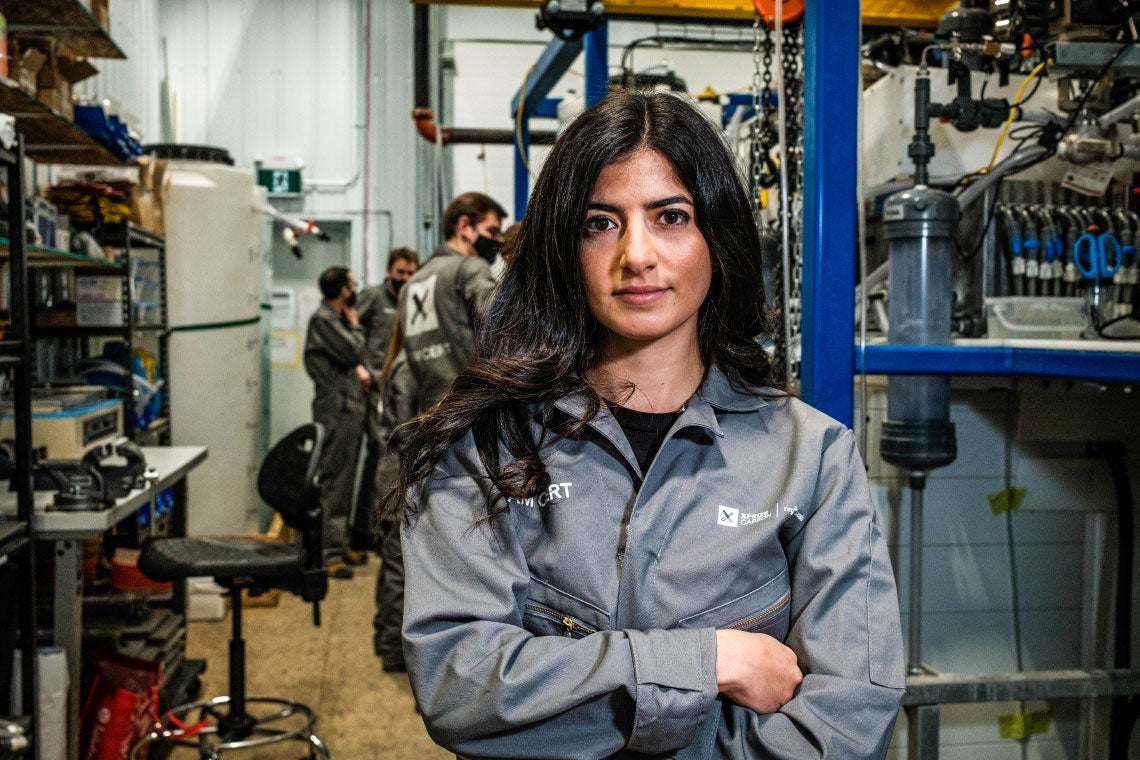Transforming CO2 into shampoo and garden furniture? University of Toronto startup is doing what ‘no one has done before’
When Christine Gabardo joined CERT Systems in 2019, it found itself in the middle of a five-year global competition to fight rising greenhouse gases with game-changing technologies.
The team reached the semi-finals of NRG COSIA Carbon XPRIZE through a process that merges chemistry, materials science and mechanical engineering to turn CO2 into ethylene – used to make an assortment of everyday items, from shampoo to manufactured plastics and mattresses.
Gabardo played a leading role in helping CERT – which grew out of research at the University of Toronto’s Faculty of Applied Science and Engineering – progress to the finals by expanding its reactor, originally the size of a Rubik’s cube cell, plus more than 10,000 times to process 100 kilograms of CO2 per day.
“I found it really interesting that electrochemistry could be used to address one of our world’s greatest challenges, which is climate change,” says Gabardo, co-founder and chief technology officer at CERT and former postdoctoral researcher at the University of Toronto.
“It’s exciting to get to work with cutting-edge technology, especially on something no one has done before.”
Currently, fossil fuels are used to produce approximately 158,000,000 tonnes of ethylene per year.
CERT, on the other hand, uses water and electricity to turn waste CO2 into ethylene and other carbon-based fuels using an electrocatalyst operating at room temperature and atmospheric pressure. The catalyst is able to break down and reform CO2 into larger, valuable molecules with electricity and protons from water. The process allows CERT to manufacture chemically identical ethylene otherwise produced from fossil fuels.
“If we can decarbonize the production of ethylene, then we can decarbonize all the materials downstream of it,” says Gabardo, who is also a research associate at the Sinton Group.
“This will help tackle CO2 emissions from the chemical industry to consumer goods.”
Co-founded by Gabardo and Alex IP, CERT is supported by research from two groups of engineering laboratories; the Sinton Group, led by David Sintonprofessor in the department of mechanical and industrial engineering, and the Sargent Groupit’s Ted Sargentwho was then based in the Electrical and Computer Engineering Department of Edward S. Rogers Sr.
CERT is also supported by Breakthrough Energy Solutions Canadawhich brings together some of the country’s top clean energy leaders and investors to accelerate companies with new solutions to reduce greenhouse gas emissions.
For Gabardo, the balance between the worlds of science, technology and entrepreneurship has always been in the cards. She says she has been fascinated by the idea of inventing things since childhood.
“I’ve always been interested in starting a business,” says Gabardo. “I just didn’t know what point in my career that would happen.”
“I thought to myself, ‘I just want to join a startup,'” says Gabardo.
Like fellow co-founder Ip, Gabardo came from a technical background. She studied Electrical and Biomedical Engineering at McMaster University, where she developed electrochemical devices for point-of-care diagnostics of infectious diseases. While its technical skills were transferable to scaling CERT’s CO2 conversion technology during the XPRIZE competition, the company also needed help to grow its business beyond academia and into the mainstream. to marketing.
Thus, CERT relied on the entrepreneurial community at U of T – in particular, the University of Toronto Startup Technology Program (UTEST). The program supports U of T entrepreneurs building research-based businesses and offers a range of services including investment capital, business strategy, and mentorship. This includes providing startups with educational and networking support through Marchan intensive entrepreneurship training program that connects entrepreneurs with a range of local professionals and investors.
“It’s not even easy to start a business,” says Gabardo. “We were able to tap into the U of T startup community and ask some valuable questions. Just being honest about what you need help with and asking for resources will speed up how you can get started.
With a lab currently under construction on the U of T’s downtown campus, CERT will soon be able to continue its work where its journey began. The pilot unit will allow CERT to continue to refine its process to improve its efficiency and produce ethylene and other products (such as ethanol) on a significant scale.
For Sinton, the move couldn’t come at a better time, especially with the university’s plan to achieve a climate-positive St. George campus by 2050.
“The University of Toronto has been very supportive of the project,” says Sinton. “They embraced us and viewed this pilot plant as a U of T facility – and one that is now coming home.
“CERT and the team are in an exciting place. They’re really mature for a start-up and have the ability to grow quickly with all the work they’ve done with their technology. »
Gabardo says CERT is currently focused on growing its team, finding seed funding, and building more strategic partnerships. Over the next five years, Gabardo hopes to increase the CO2 capacity the CERT pilot reactor can process per day, scale to a commercial unit, and work with industrial partners to produce valuable products.
She makes it a priority to mentor and support other women in the lab and cooperative students who work for CERT, saying it is important to ensure women see themselves in leadership roles.
“It’s hard to get into a field where it’s usually male-dominated and there aren’t a lot of people you can identify with,” says Gabardo. “Trying to be that example for others is something that I think is important.
“If something interests you and you have the passion to pursue it, don’t let people’s opinions stop you. Keep working on it no matter what.


Comments are closed.